ECU MERCEDES-BENZ C-Class SEDAN 2015 W205 Owner's Manual
[x] Cancel search | Manufacturer: MERCEDES-BENZ, Model Year: 2015, Model line: C-Class SEDAN, Model: MERCEDES-BENZ C-Class SEDAN 2015 W205Pages: 406, PDF Size: 7.62 MB
Page 15 of 406
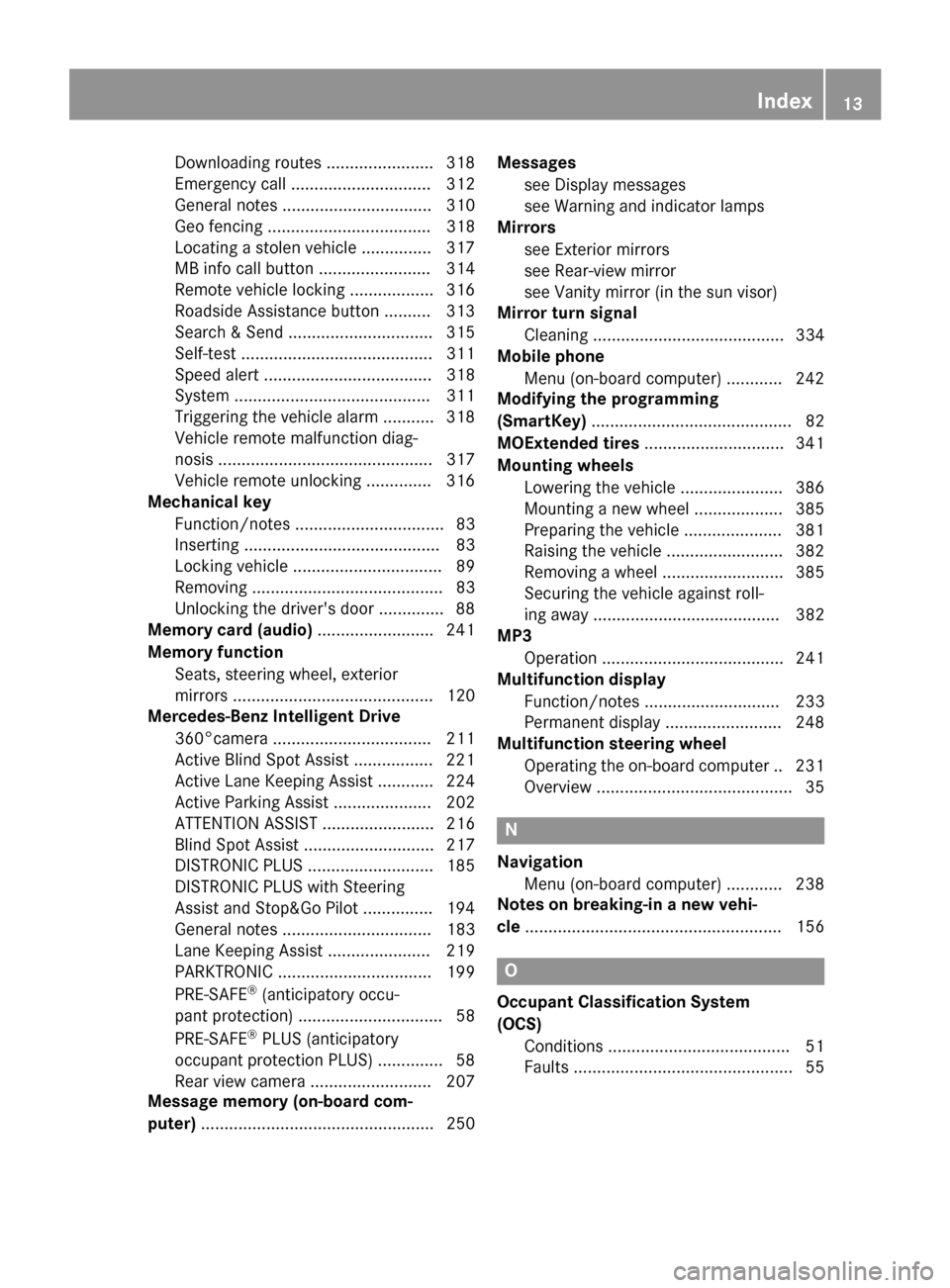
Downloading routes ....................... 318
Emergency call .............................. 312
General notes ................................ 310
Geo fencing ................................... 318
Locating a stolen vehicle ............... 317
MB info call button ........................ 314
Remote vehicle locking .................. 316
Roadside Assistance button .......... 313
Search & Send ............................... 315
Self-test ......................................... 311
Speed alert .................................... 318
System .......................................... 311
Triggering the vehicle alar m........... 318
Vehicle remote malfunction diag-
nosis .............................................. 317
Vehicle remote unlocking .............. 316
Mechanical key
Function/note s................................ 83
Inserting .......................................... 83
Locking vehicle ................................ 89
Removing ......................................... 83
Unlocking the driver's doo r.............. 88
Memory card (audio) ......................... 241
Memory function Seats, steering wheel, exterior
mirrors ........................................... 120
Mercedes-Benz Intelligent Drive
360°camera .................................. 211
Active Blind Spot Assist ................. 221
Active Lane Keeping Assist ............ 224
Active Parking Assist ..................... 202
ATTENTION ASSIST ........................ 216
Blind Spot Assist ............................ 217
DISTRONIC PLUS ........................... 185
DISTRONIC PLUS with Steering
Assist and Stop&Go Pilot ............... 194
General notes ................................ 183
Lane Keeping Assist ...................... 219
PARKTRONIC ................................. 199
PRE-SAFE ®
(anticipatory occu-
pant protection) ............................... 58
PRE-SAFE ®
PLUS (anticipatory
occupant protection PLUS) .............. 58
Rear view camera .......................... 207
Message memory (on-board com-
puter) .................................................. 250 Messages
see Display messages
see Warning and indicator lamps
Mirrors
see Exterior mirrors
see Rear-view mirror
see Vanity mirror (in the sun visor)
Mirror turn signal
Cleaning ......................................... 334
Mobile phone
Menu (on-board computer) ............ 242
Modifying the programming
(SmartKey) ........................................... 82
MOExtended tires .............................. 341
Mounting wheels Lowering the vehicle ...................... 386
Mounting a new wheel ................... 385
Preparing the vehicle ..................... 381
Raising the vehicle ......................... 382
Removing a whee l.......................... 385
Securing the vehicle against roll-
ing away ........................................ 382
MP3
Operation ....................................... 241
Multifunction display
Function/note s............................. 233
Permanent display ......................... 248
Multifunction steering wheel
Operating the on-board compute r..2 31
Overview .......................................... 35 N
Navigation Menu (on-board computer) ............ 238
Notes on breaking-in a new vehi-
cle ....................................................... 156 O
Occupant Classification System
(OCS) Conditions ....................................... 51
Faults ............................................... 55 Index
13
Page 17 of 406
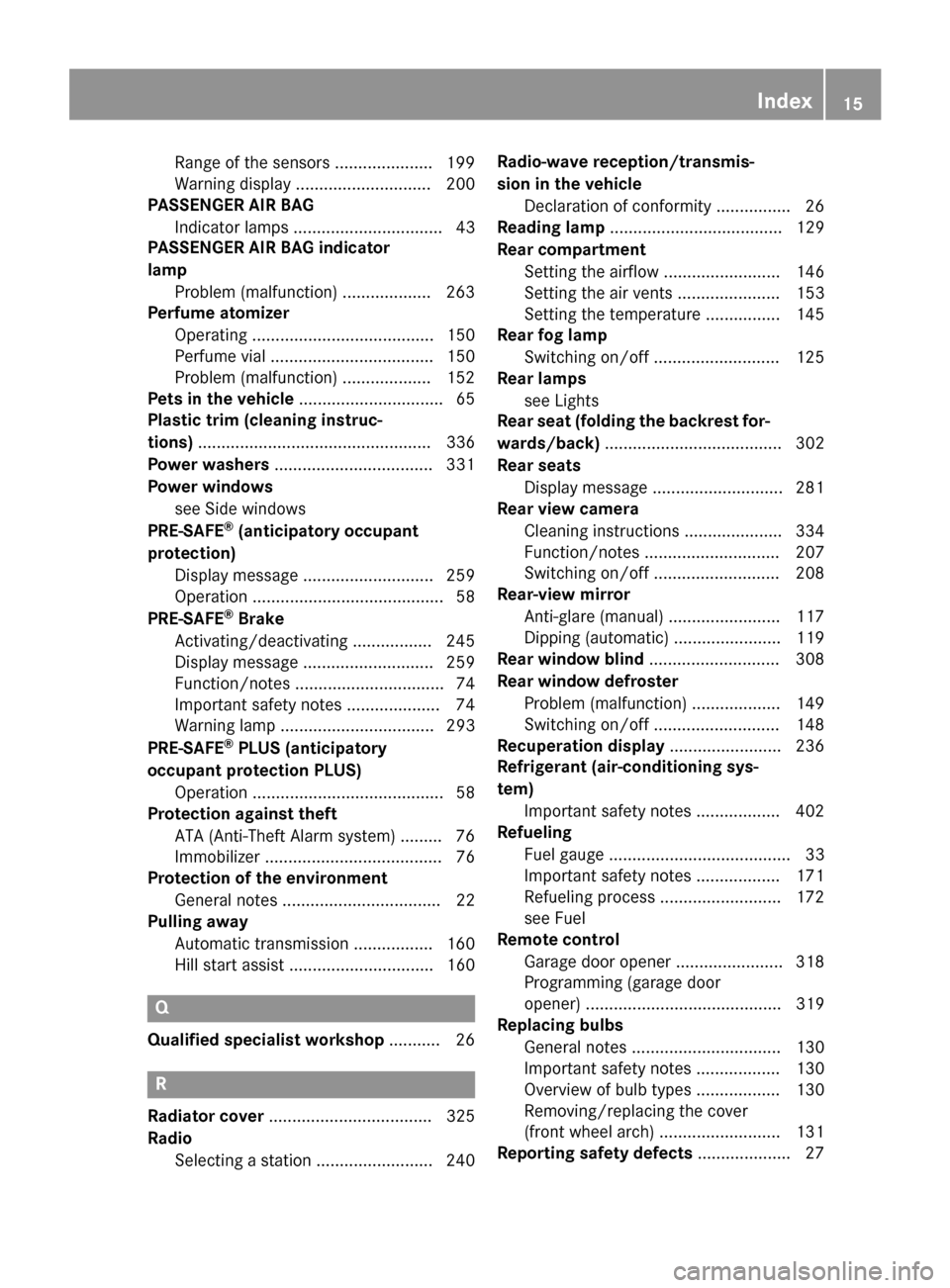
Range of the sensors ....................
.199
Warning displa y............................. 200
PASSENGER AIR BAG
Indicator lamps ................................ 43
PASSENGER AIR BAG indicator
lamp
Problem (malfunction) ................... 263
Perfume atomizer
Operating ....................................... 150
Perfume vial ................................... 150
Problem (malfunction) ................... 152
Pets in the vehicle ............................... 65
Plastic trim (cleaning instruc-
tions) .................................................. 336
Power washers .................................. 331
Power windows see Side windows
PRE-SAFE ®
(anticipatory occupant
protection) Display message ............................ 259
Operation ......................................... 58
PRE-SAFE ®
Brake
Activating/deactivating ................. 245
Display message ............................ 259
Function/note s................................ 74
Important safety notes .................... 74
Warning lamp ................................. 293
PRE-SAFE ®
PLUS (anticipatory
occupant protection PLUS) Operation ......................................... 58
Protection against theft
ATA (Anti-Theft Alarm system) ......... 76
Immobilizer ...................................... 76
Protection of the environment
General notes .................................. 22
Pulling away
Automatic transmission ................. 160
Hill start assist ............................... 160 Q
Qualified specialist workshop ........... 26R
Radiator cover ................................... 325
Radio Selecting a station ......................... 240 Radio-wave reception/transmis-
sion in the vehicle
Declaration of conformity ................ 26
Reading lamp ..................................... 129
Rear compartment Setting the airflow ......................... 146
Setting the air vents ...................... 153
Setting the temperature ................ 145
Rear fog lamp
Switching on/of f........................... 125
Rear lamps
see Lights
Rear seat (folding the backrest for-
wards/back) ...................................... 302
Rear seats Display message ............................ 281
Rear view camera
Cleaning instructions ..................... 334
Function/note s............................. 207
Switching on/of f........................... 208
Rear-view mirror
Anti-glare (manual) ........................ 117
Dipping (automatic) ....................... 119
Rear window blind ............................ 308
Rear window defroster Problem (malfunction) ................... 149
Switching on/of f........................... 148
Recuperation display ........................ 236
Refrigerant (air-conditioning sys-
tem) Important safety notes .................. 402
Refueling
Fuel gauge ....................................... 33
Important safety notes .................. 171
Refueling process .......................... 172
see Fuel
Remote control
Garage door opener ....................... 318
Programming (garage door
opener) .......................................... 319
Replacing bulbs
General notes ................................ 130
Important safety notes .................. 130
Overview of bulb types .................. 130
Removing/replacing the cover
(front wheel arch) .......................... 131
Reporting safety defects .................... 27 Index
15
Page 22 of 406
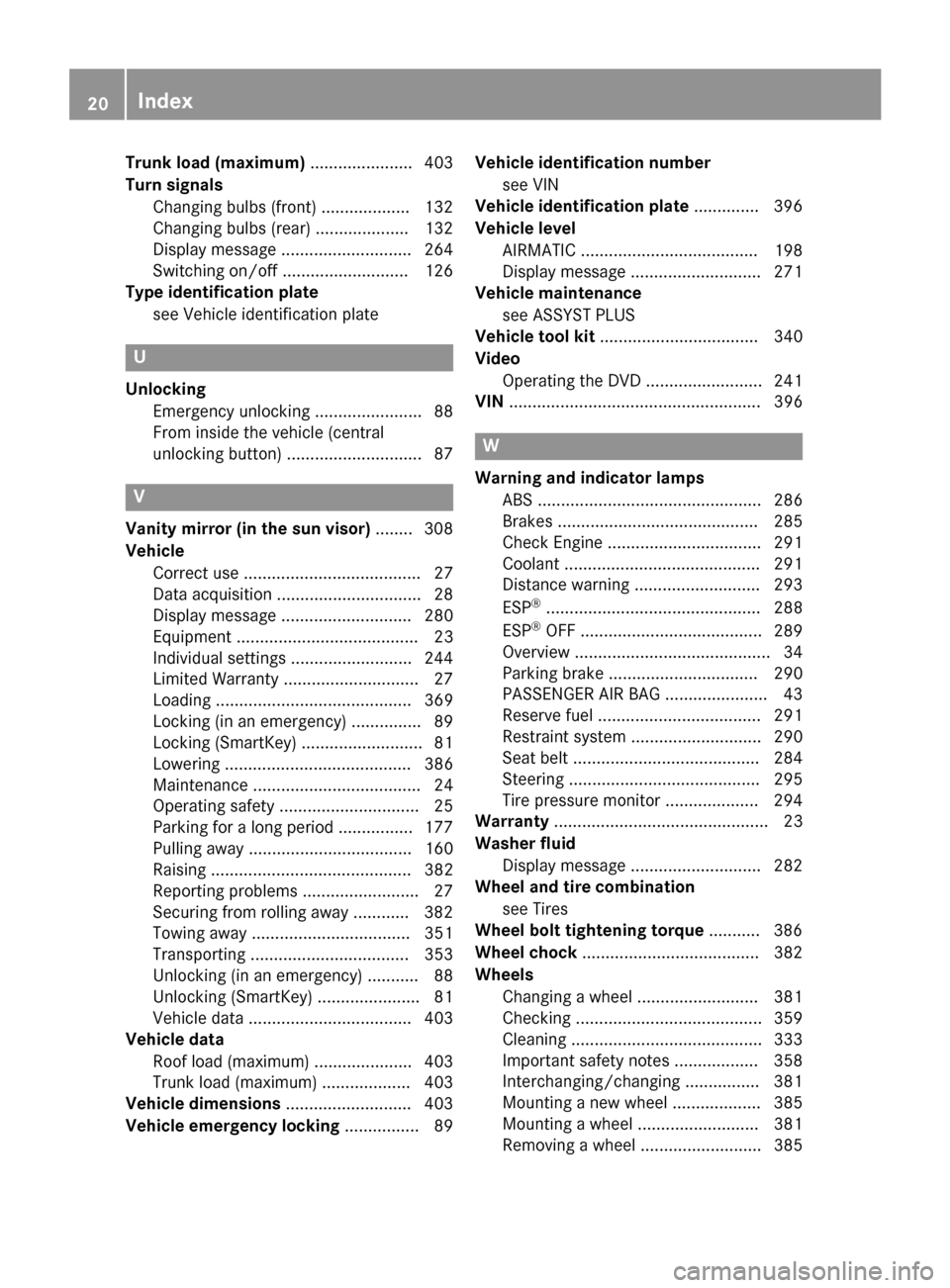
Trunk load (maximum)
...................... 403
Turn signals Changing bulbs (front) ................... 132
Changing bulbs (rear ).................... 132
Display message ............................ 264
Switching on/of f........................... 126
Type identification plate
see Vehicle identification plate U
Unlocking Emergency unlocking ....................... 88
From inside the vehicle (central
unlocking button) ............................. 87 V
Vanity mirror (in the sun visor) ........ 308
Vehicle Correct use ...................................... 27
Data acquisition ............................... 28
Display message ............................ 280
Equipment ....................................... 23
Individual settings .......................... 244
Limited Warranty ............................. 27
Loading .......................................... 369
Locking (in an emergency) ............... 89
Locking (SmartKey ).......................... 81
Lowering ........................................ 386
Maintenance .................................... 24
Operating safety .............................. 25
Parking for a long period ................ 177
Pulling away ................................... 160
Raising ........................................... 382
Reporting problems ......................... 27
Securing from rolling away ............ 382
Towing away .................................. 351
Transporting .................................. 353
Unlocking (in an emergency) ........... 88
Unlocking (SmartKey )...................... 81
Vehicle data ................................... 403
Vehicle data
Roof load (maximum) ..................... 403
Trunk load (maximum) ................... 403
Vehicle dimensions ........................... 403
Vehicle emergency locking ................ 89Vehicle identification number
see VIN
Vehicle identification plate .............. 396
Vehicle level AIRMATIC ...................................... 198
Display message ............................ 271
Vehicle maintenance
see ASSYST PLUS
Vehicle tool kit .................................. 340
Video Operating the DVD ......................... 241
VIN ...................................................... 396 W
Warning and indicator lamps ABS ................................................ 286
Brakes ........................................... 285
Check Engine ................................. 291
Coolant .......................................... 291
Distance warning ........................... 293
ESP ®
.............................................. 288
ESP ®
OFF ....................................... 289
Overview .......................................... 34
Parking brake ................................ 290
PASSENGER AIR BAG ...................... 43
Reserve fue l................................... 291
Restraint system ............................ 290
Seat belt ........................................ 284
Steering ......................................... 295
Tire pressure monitor .................... 294
Warranty .............................................. 23
Washer fluid Display message ............................ 282
Wheel and tire combination
see Tires
Wheel bolt tightening torque ........... 386
Wheel chock ...................................... 382
Wheels Changing a whee l.......................... 381
Checking ........................................ 359
Cleaning ......................................... 333
Important safety notes .................. 358
Interchanging/changing ................ 381
Mounting a new whee l................... 385
Mounting a whee l.......................... 381
Removing a whee l.......................... 385 20
Index
Page 28 of 406
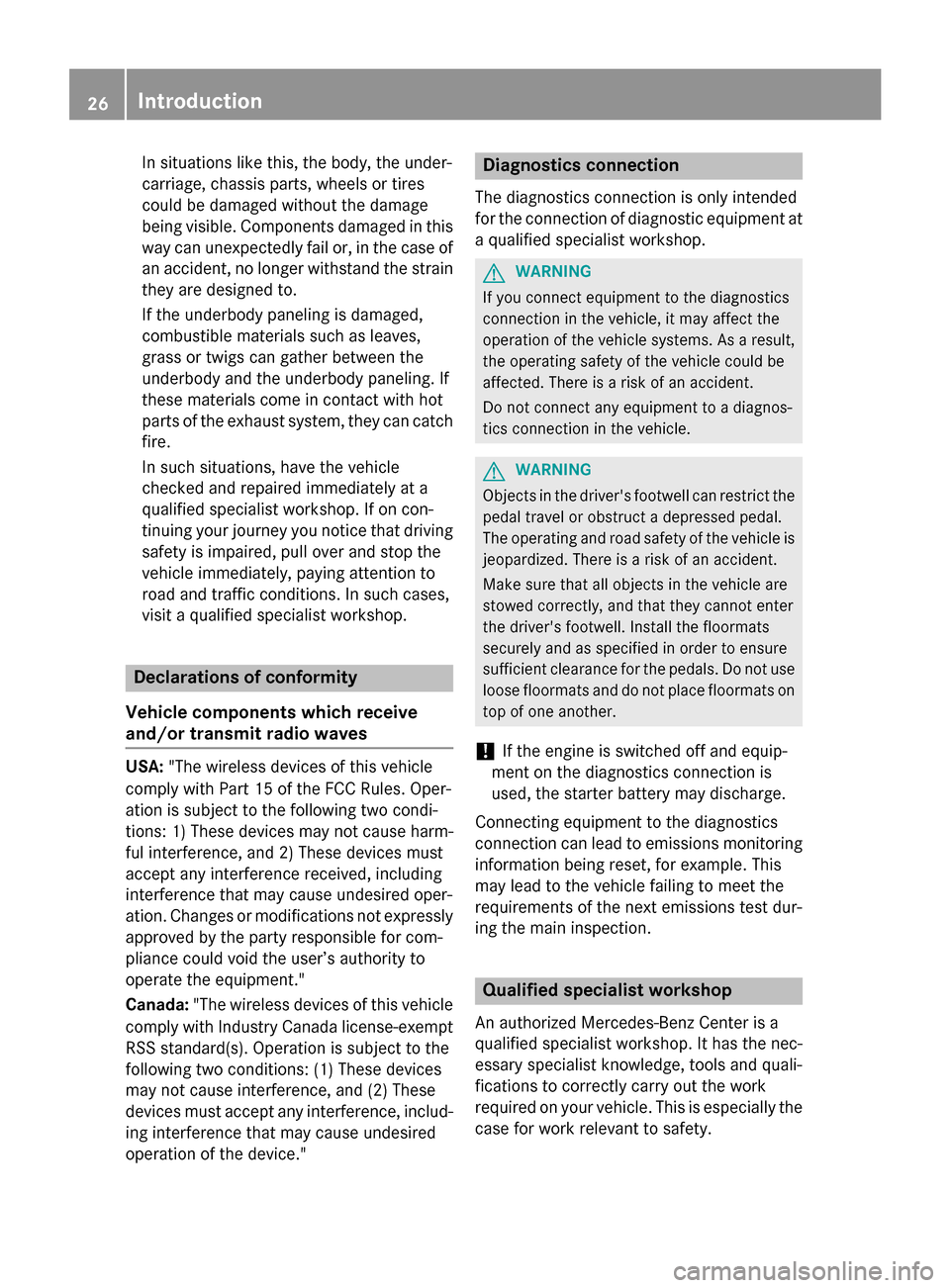
In situations like this, the body, the under-
carriage, chassis parts, wheels or tires
could be damaged without the damage
being visible. Components damaged in this way can unexpectedly fail or, in the case of
an accident, no longer withstand the strain
they are designed to.
If the underbody paneling is damaged,
combustible materials such as leaves,
grass or twigs can gather between the
underbody and the underbody paneling. If
these materials come in contact with hot
parts of the exhaust system, they can catch fire.
In such situations, have the vehicle
checked and repaired immediately at a
qualified specialist workshop. If on con-
tinuing your journey you notice that driving
safety is impaired, pull over and stop the
vehicle immediately, paying attention to
road and traffic conditions. In such cases,
visit a qualified specialist workshop. Declarations of conformity
Vehicle components which receive
and/or transmit radio waves USA:
"The wireless devices of this vehicle
comply with Part 15 of the FCC Rules. Oper-
ation is subject to the following two condi-
tions: 1) These devices may not cause harm-
ful interference, and 2) These devices must
accept any interference received, including
interference that may cause undesired oper-
ation. Changes or modifications not expressly approved by the party responsible for com-
pliance could void the user’s authority to
operate the equipment."
Canada: "The wireless devices of this vehicle
comply with Industry Canada license-exempt RSS standard(s). Operation is subject to the
following two conditions: (1) These devices
may not cause interference, and (2) These
devices must accept any interference, includ-
ing interference that may cause undesired
operation of the device." Diagnostics connection
The diagnostics connection is only intended
for the connection of diagnostic equipment at
a qualified specialist workshop. G
WARNING
If you connect equipment to the diagnostics
connection in the vehicle, it may affect the
operation of the vehicle systems. As a result, the operating safety of the vehicle could be
affected. There is a risk of an accident.
Do not connect any equipment to a diagnos-
tics connection in the vehicle. G
WARNING
Objects in the driver's footwell can restrict the pedal travel or obstruct a depressed pedal.
The operating and road safety of the vehicle is
jeopardized. There is a risk of an accident.
Make sure that all objects in the vehicle are
stowed correctly, and that they cannot enter
the driver's footwell. Install the floormats
securely and as specified in order to ensure
sufficient clearance for the pedals. Do not use loose floormats and do not place floormats on
top of one another.
! If the engine is switched off and equip-
ment on the diagnostics connection is
used, the starter battery may discharge.
Connecting equipment to the diagnostics
connection can lead to emissions monitoring information being reset, for example. This
may lead to the vehicle failing to meet the
requirements of the next emissions test dur-
ing the main inspection. Qualified specialist workshop
An authorized Mercedes-Benz Center is a
qualified specialist workshop. It has the nec-
essary specialist knowledge, tools and quali-
fications to correctly carry out the work
required on your vehicle. This is especially the case for work relevant to safety. 26
Introduction
Page 44 of 406
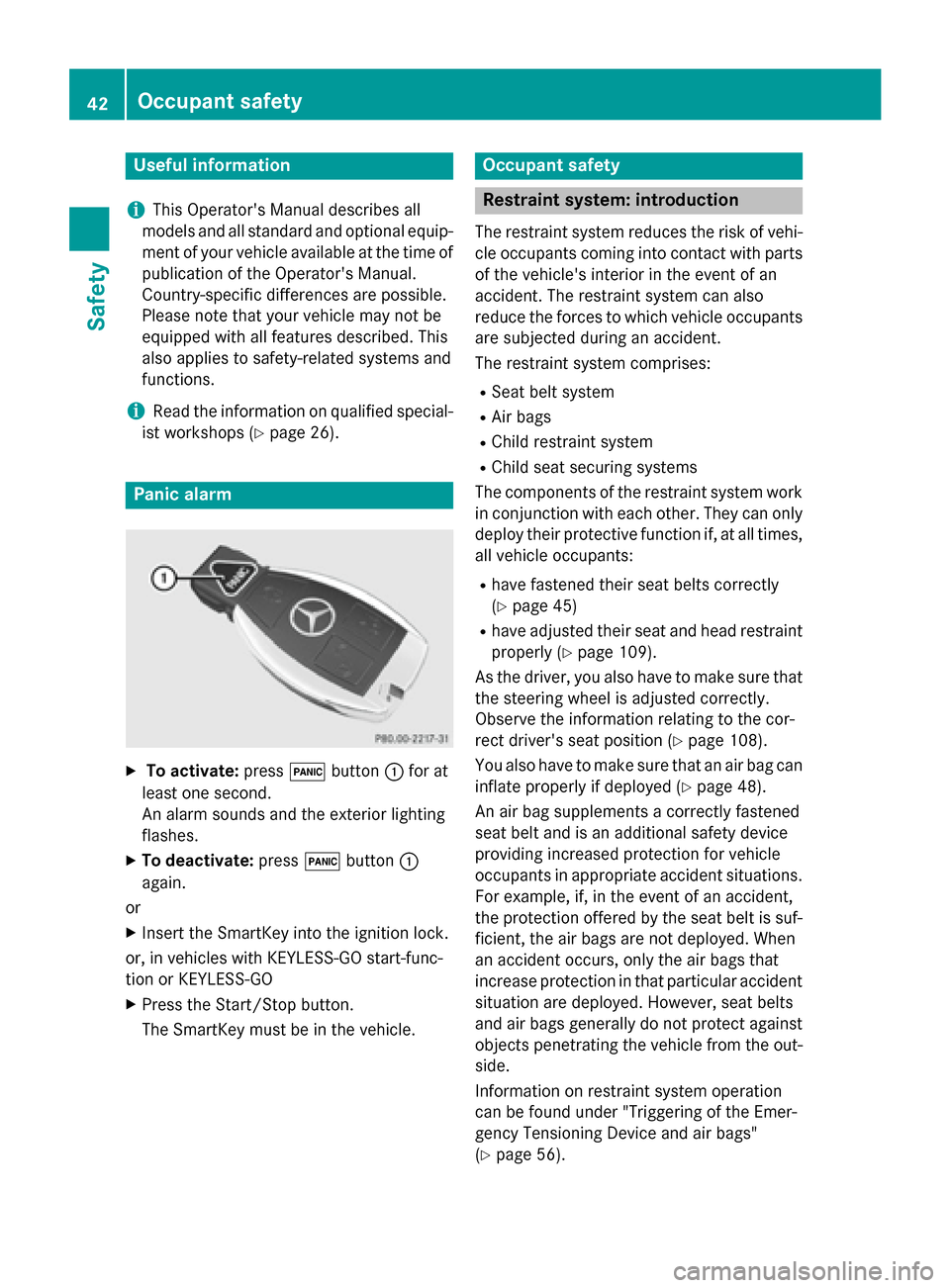
Useful information
i This Operator's Manual describes all
models and all standard and optional equip- ment of your vehicle available at the time of
publication of the Operator's Manual.
Country-specific differences are possible.
Please note that your vehicle may not be
equipped with all features described. This
also applies to safety-related systems and
functions.
i Read the information on qualified special-
ist workshops (Y page 26). Panic alarm
X
To activate: press0033button 0043for at
least one second.
An alarm sounds and the exterior lighting
flashes.
X To deactivate: press0033button 0043
again.
or
X Insert the SmartKey into the ignition lock.
or, in vehicles with KEYLESS-GO start-func-
tion or KEYLESS ‑GO
X Press the Start/Stop button.
The SmartKey must be in the vehicle. Occupant safety
Restraint system: introduction
The restraint system reduces the risk of vehi-
cle occupants coming into contact with parts of the vehicle's interior in the event of an
accident. The restraint system can also
reduce the forces to which vehicle occupants
are subjected during an accident.
The restraint system comprises:
R Seat belt system
R Air bags
R Child restraint system
R Child seat securing systems
The components of the restraint system work
in conjunction with each other. They can only deploy their protective function if, at all times,
all vehicle occupants:
R have fastened their seat belts correctly
(Y page 45)
R have adjusted their seat and head restraint
properly (Y page 109).
As the driver, you also have to make sure that
the steering wheel is adjusted correctly.
Observe the information relating to the cor-
rect driver's seat position (Y page 108).
You also have to make sure that an air bag can inflate properly if deployed (Y page 48).
An air bag supplements a correctly fastened
seat belt and is an additional safety device
providing increased protection for vehicle
occupants in appropriate accident situations.
For example, if, in the event of an accident,
the protection offered by the seat belt is suf-
ficient, the air bags are not deployed. When
an accident occurs, only the air bags that
increase protection in that particular accident
situation are deployed. However, seat belts
and air bags generally do not protect against objects penetrating the vehicle from the out-
side.
Information on restraint system operation
can be found under "Triggering of the Emer-
gency Tensioning Device and air bags"
(Y page 56). 42
Occupant safetySafety
Page 47 of 406
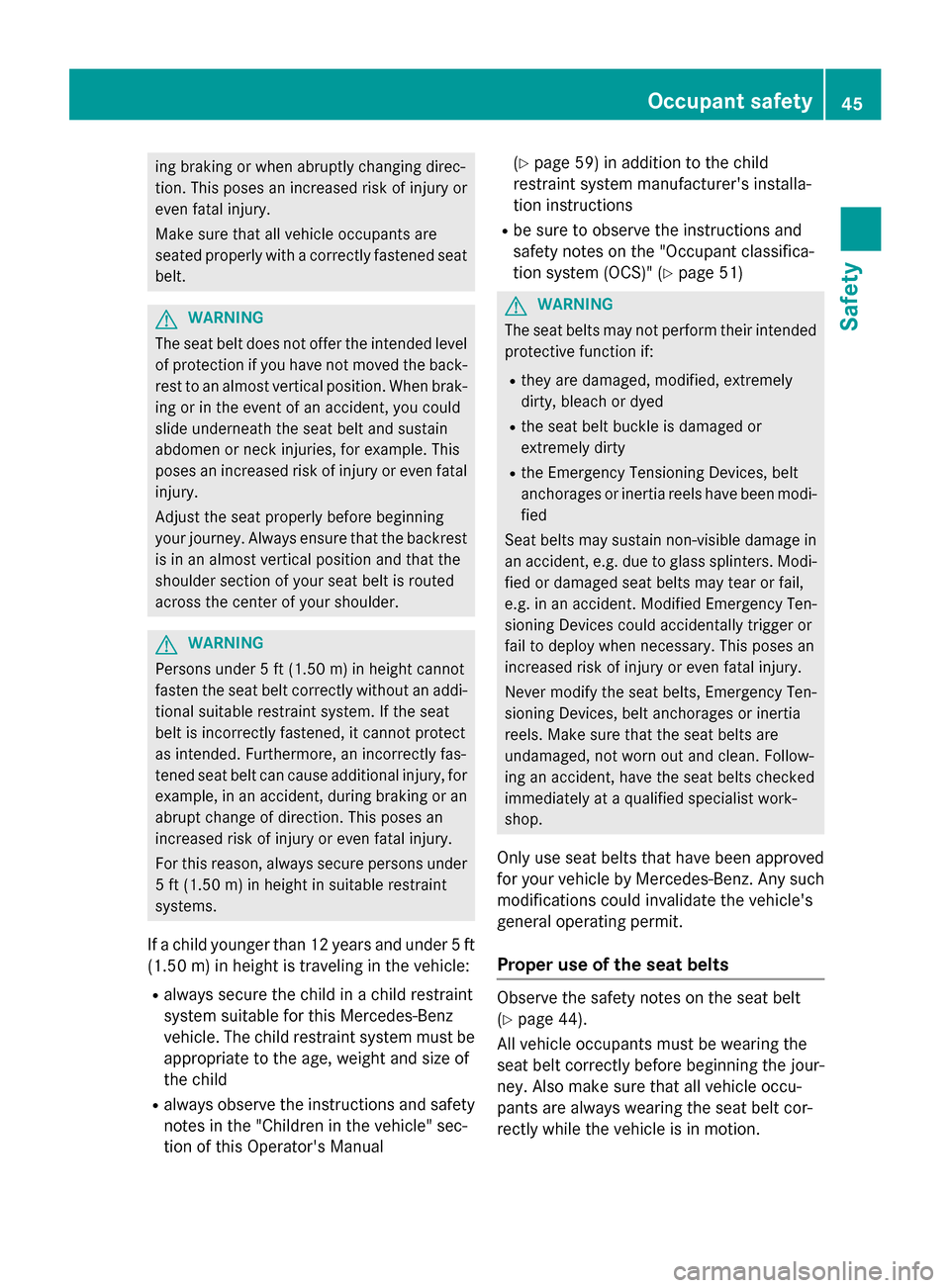
ing braking or when abruptly changing direc-
tion. This poses an increased risk of injury or
even fatal injury.
Make sure that all vehicle occupants are
seated properly with a correctly fastened seat belt. G
WARNING
The seat belt does not offer the intended level of protection if you have not moved the back-
rest to an almost vertical position. When brak-
ing or in the event of an accident, you could
slide underneath the seat belt and sustain
abdomen or neck injuries, for example. This
poses an increased risk of injury or even fatal injury.
Adjust the seat properly before beginning
your journey. Always ensure that the backrest
is in an almost vertical position and that the
shoulder section of your seat belt is routed
across the center of your shoulder. G
WARNING
Persons under 5 ft (1.50 m) in height cannot
fasten the seat belt correctly without an addi- tional suitable restraint system. If the seat
belt is incorrectly fastened, it cannot protect
as intended. Furthermore, an incorrectly fas-
tened seat belt can cause additional injury, for
example, in an accident, during braking or an
abrupt change of direction. This poses an
increased risk of injury or even fatal injury.
For this reason, always secure persons under
5 ft (1.50 m) in height in suitable restraint
systems.
If a child younger than 12 years and under 5 ft
(1.50 m) in height is traveling in the vehicle:
R always secure the child in a child restraint
system suitable for this Mercedes-Benz
vehicle. The child restraint system must be
appropriate to the age, weight and size of
the child
R always observe the instructions and safety
notes in the "Children in the vehicle" sec-
tion of this Operator's Manual (Y
page 59) in addition to the child
restraint system manufacturer's installa-
tion instructions
R be sure to observe the instructions and
safety notes on the "Occupant classifica-
tion system (OCS)" (Y page 51) G
WARNING
The seat belts may not perform their intended protective function if:
R they are damaged, modified, extremely
dirty, bleach or dyed
R the seat belt buckle is damaged or
extremely dirty
R the Emergency Tensioning Devices, belt
anchorages or inertia reels have been modi-
fied
Seat belts may sustain non-visible damage in an accident, e.g. due to glass splinters. Modi-
fied or damaged seat belts may tear or fail,
e.g. in an accident. Modified Emergency Ten-
sioning Devices could accidentally trigger or
fail to deploy when necessary. This poses an
increased risk of injury or even fatal injury.
Never modify the seat belts, Emergency Ten-
sioning Devices, belt anchorages or inertia
reels. Make sure that the seat belts are
undamaged, not worn out and clean. Follow-
ing an accident, have the seat belts checked
immediately at a qualified specialist work-
shop.
Only use seat belts that have been approved
for your vehicle by Mercedes-Benz. Any such
modifications could invalidate the vehicle's
general operating permit.
Proper use of the seat belts Observe the safety notes on the seat belt
(Y
page 44).
All vehicle occupants must be wearing the
seat belt correctly before beginning the jour-
ney. Also make sure that all vehicle occu-
pants are always wearing the seat belt cor-
rectly while the vehicle is in motion. Occupant safety
45Safety Z
Page 48 of 406
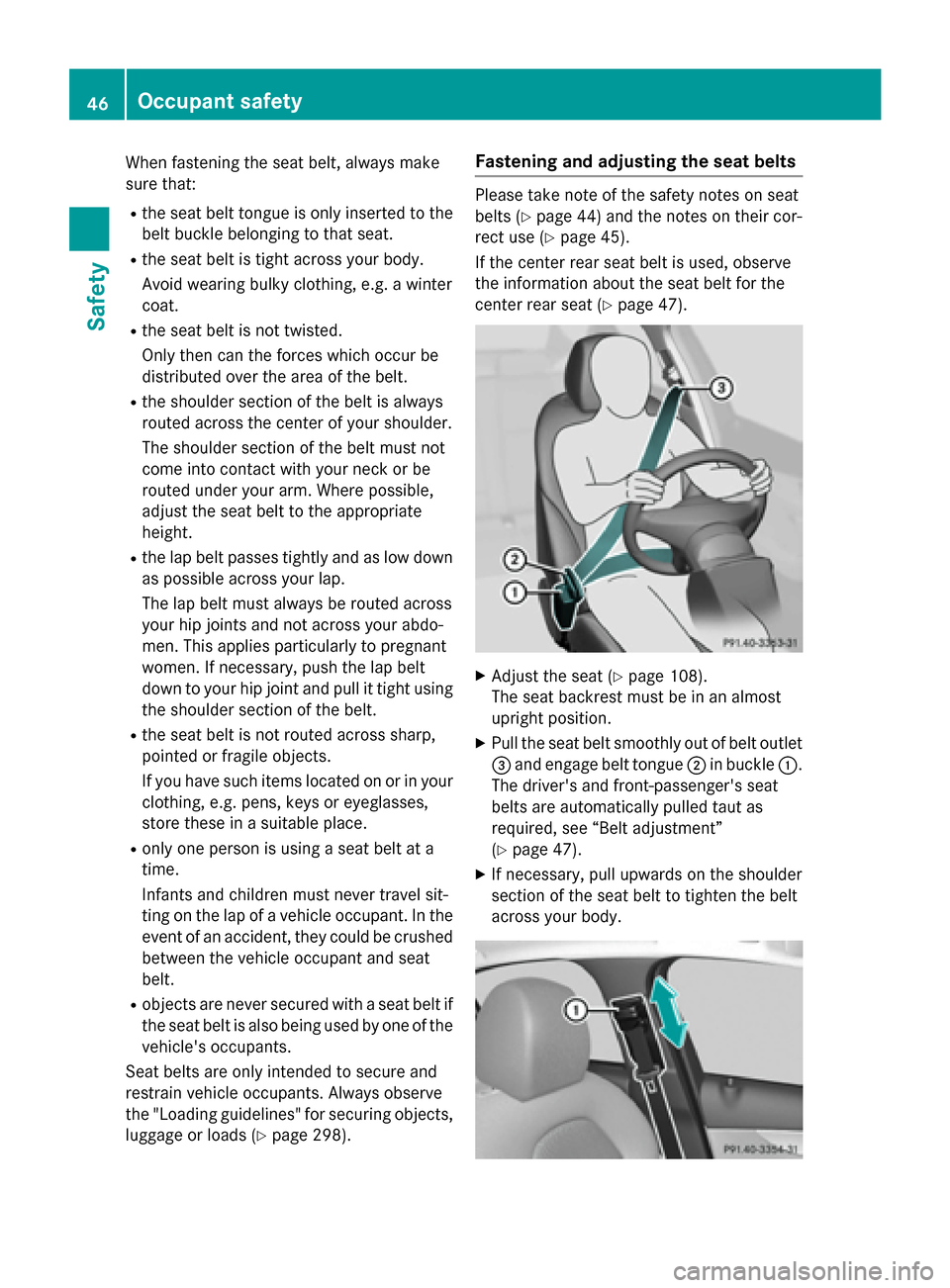
When fastening the seat belt, always make
sure that:
R the seat belt tongue is only inserted to the
belt buckle belonging to that seat.
R the seat belt is tight across your body.
Avoid wearing bulky clothing, e.g. a winter
coat.
R the seat belt is not twisted.
Only then can the forces which occur be
distributed over the area of the belt.
R the shoulder section of the belt is always
routed across the center of your shoulder.
The shoulder section of the belt must not
come into contact with your neck or be
routed under your arm. Where possible,
adjust the seat belt to the appropriate
height.
R the lap belt passes tightly and as low down
as possible across your lap.
The lap belt must always be routed across
your hip joints and not across your abdo-
men. This applies particularly to pregnant
women. If necessary, push the lap belt
down to your hip joint and pull it tight using the shoulder section of the belt.
R the seat belt is not routed across sharp,
pointed or fragile objects.
If you have such items located on or in your clothing, e.g. pens, keys or eyeglasses,
store these in a suitable place.
R only one person is using a seat belt at a
time.
Infants and children must never travel sit-
ting on the lap of a vehicle occupant. In the
event of an accident, they could be crushed
between the vehicle occupant and seat
belt.
R objects are never secured with a seat belt if
the seat belt is also being used by one of the
vehicle's occupants.
Seat belts are only intended to secure and
restrain vehicle occupants. Always observe
the "Loading guidelines" for securing objects,
luggage or loads (Y page 298). Fastening and adjusting the seat belts Please take note of the safety notes on seat
belts (Y
page 44) and the notes on their cor-
rect use (Y page 45).
If the center rear seat belt is used, observe
the information about the seat belt for the
center rear seat (Y page 47). X
Adjust the seat (Y page 108).
The seat backrest must be in an almost
upright position.
X Pull the seat belt smoothly out of belt outlet
0087 and engage belt tongue 0044in buckle 0043.
The driver's and front-passenger's seat
belts are automatically pulled taut as
required, see “Belt adjustment”
(Y page 47).
X If necessary, pull upwards on the shoulder
section of the seat belt to tighten the belt
across your body. 46
Occupant safetySafety
Page 49 of 406
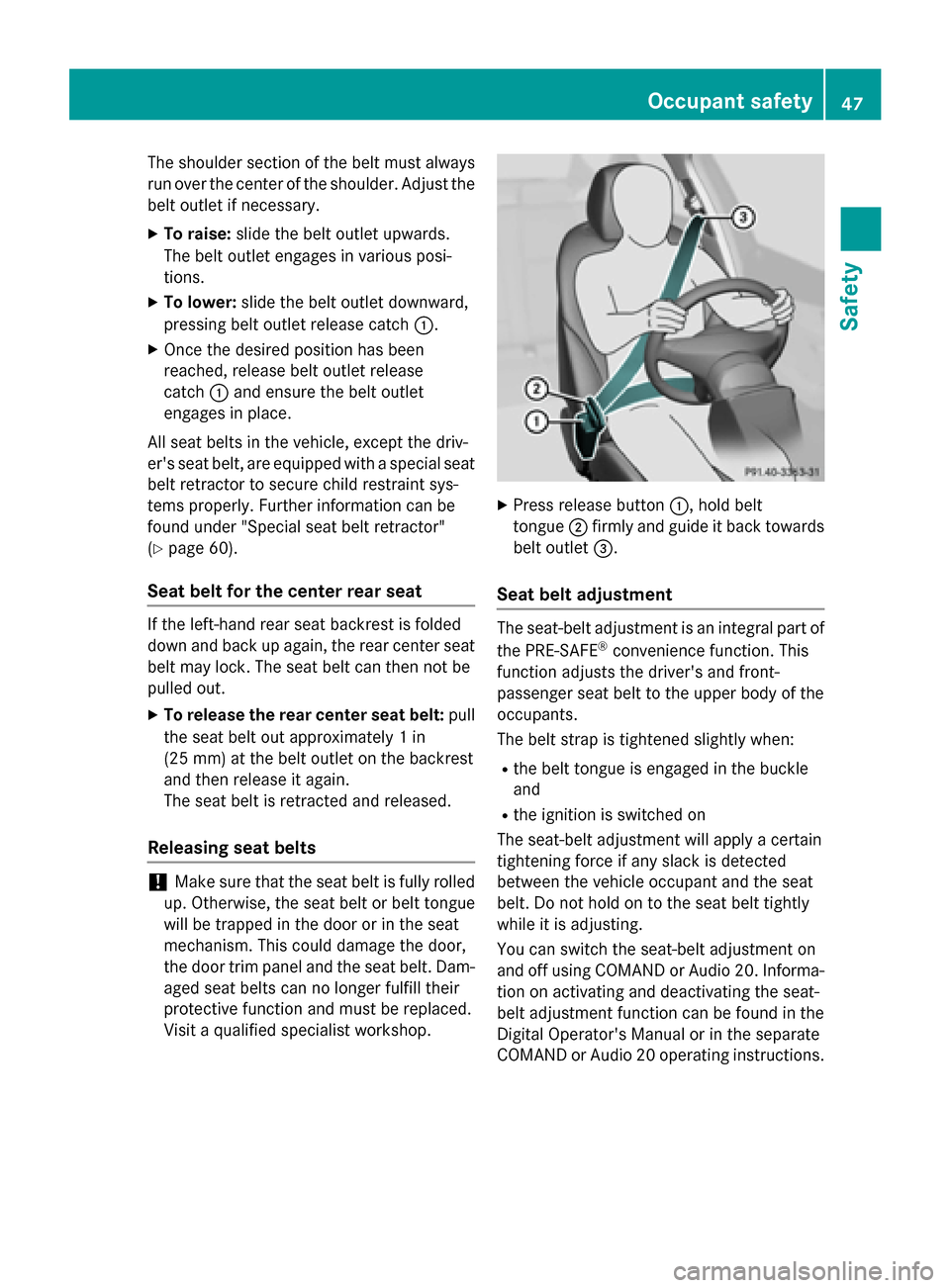
The shoulder section of the belt must always
run over the center of the shoulder. Adjust the
belt outlet if necessary.
X To raise: slide the belt outlet upwards.
The belt outlet engages in various posi-
tions.
X To lower: slide the belt outlet downward,
pressing belt outlet release catch 0043.
X Once the desired position has been
reached, release belt outlet release
catch 0043and ensure the belt outlet
engages in place.
All seat belts in the vehicle, except the driv-
er's seat belt, are equipped with a special seat belt retractor to secure child restraint sys-
tems properly. Further information can be
found under "Special seat belt retractor"
(Y page 60).
Seat belt for the center rear seat If the left-hand rear seat backrest is folded
down and back up again, the rear center seat
belt may lock. The seat belt can then not be
pulled out.
X To release the rear center seat belt: pull
the seat belt out approximately 1 in
(25 mm) at the belt outlet on the backrest
and then release it again.
The seat belt is retracted and released.
Releasing seat belts !
Make sure that the seat belt is fully rolled
up. Otherwise, the seat belt or belt tongue
will be trapped in the door or in the seat
mechanism. This could damage the door,
the door trim panel and the seat belt. Dam- aged seat belts can no longer fulfill their
protective function and must be replaced.
Visit a qualified specialist workshop. X
Press release button 0043, hold belt
tongue 0044firmly and guide it back towards
belt outlet 0087.
Seat belt adjustment The seat-belt adjustment is an integral part of
the PRE-SAFE ®
convenience function. This
function adjusts the driver's and front-
passenger seat belt to the upper body of the
occupants.
The belt strap is tightened slightly when:
R the belt tongue is engaged in the buckle
and
R the ignition is switched on
The seat-belt adjustment will apply a certain
tightening force if any slack is detected
between the vehicle occupant and the seat
belt. Do not hold on to the seat belt tightly
while it is adjusting.
You can switch the seat-belt adjustment on
and off using COMAND or Audio 20. Informa- tion on activating and deactivating the seat-
belt adjustment function can be found in the
Digital Operator's Manual or in the separate
COMAND or Audio 20 operating instructions. Occupant safety
47Safety Z
Page 51 of 406
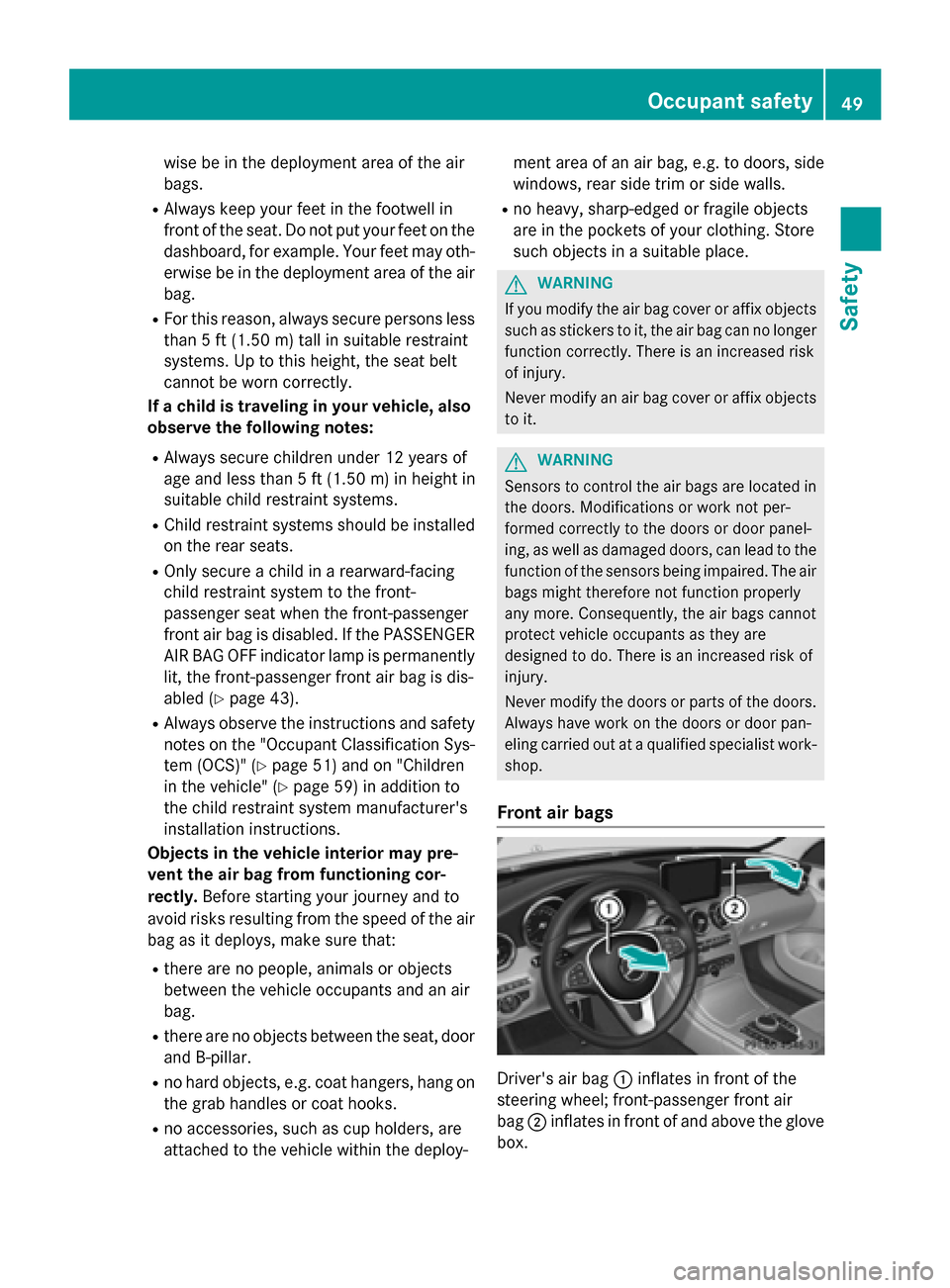
wise be in the deployment area of the air
bags.
R Always keep your feet in the footwell in
front of the seat. Do not put your feet on the
dashboard, for example. Your feet may oth-
erwise be in the deployment area of the air bag.
R For this reason, always secure persons less
than 5 ft (1.50 m) tall in suitable restraint
systems. Up to this height, the seat belt
cannot be worn correctly.
If a child is traveling in your vehicle, also
observe the following notes:
R Always secure children under 12 years of
age and less than 5 ft (1.50m)in height in
suitable child restraint systems.
R Child restraint systems should be installed
on the rear seats.
R Only secure a child in a rearward-facing
child restraint system to the front-
passenger seat when the front-passenger
front air bag is disabled. If the PASSENGER
AIR BAG OFF indicator lamp is permanently
lit, the front-passenger front air bag is dis-
abled (Y page 43).
R Always observe the instructions and safety
notes on the "Occupant Classification Sys-
tem (OCS)" (Y page 51) and on "Children
in the vehicle" (Y page 59) in addition to
the child restraint system manufacturer's
installation instructions.
Objects in the vehicle interior may pre-
vent the air bag from functioning cor-
rectly. Before starting your journey and to
avoid risks resulting from the speed of the air bag as it deploys, make sure that:
R there are no people, animals or objects
between the vehicle occupants and an air
bag.
R there are no objects between the seat, door
and B-pillar.
R no hard objects, e.g. coat hangers, hang on
the grab handles or coat hooks.
R no accessories, such as cup holders, are
attached to the vehicle within the deploy- ment area of an air bag, e.g. to doors, side
windows, rear side trim or side walls.
R no heavy, sharp-edged or fragile objects
are in the pockets of your clothing. Store
such objects in a suitable place. G
WARNING
If you modify the air bag cover or affix objects
such as stickers to it, the air bag can no longer function correctly. There is an increased risk
of injury.
Never modify an air bag cover or affix objectsto it. G
WARNING
Sensors to control the air bags are located in the doors. Modifications or work not per-
formed correctly to the doors or door panel-
ing, as well as damaged doors, can lead to the
function of the sensors being impaired. The air bags might therefore not function properly
any more. Consequently, the air bags cannot
protect vehicle occupants as they are
designed to do. There is an increased risk of
injury.
Never modify the doors or parts of the doors.
Always have work on the doors or door pan-
eling carried out at a qualified specialist work- shop.
Front air bags Driver's air bag
0043inflates in front of the
steering wheel; front-passenger front air
bag 0044inflates in front of and above the glove
box. Occupant safety
49Safety Z
Page 54 of 406
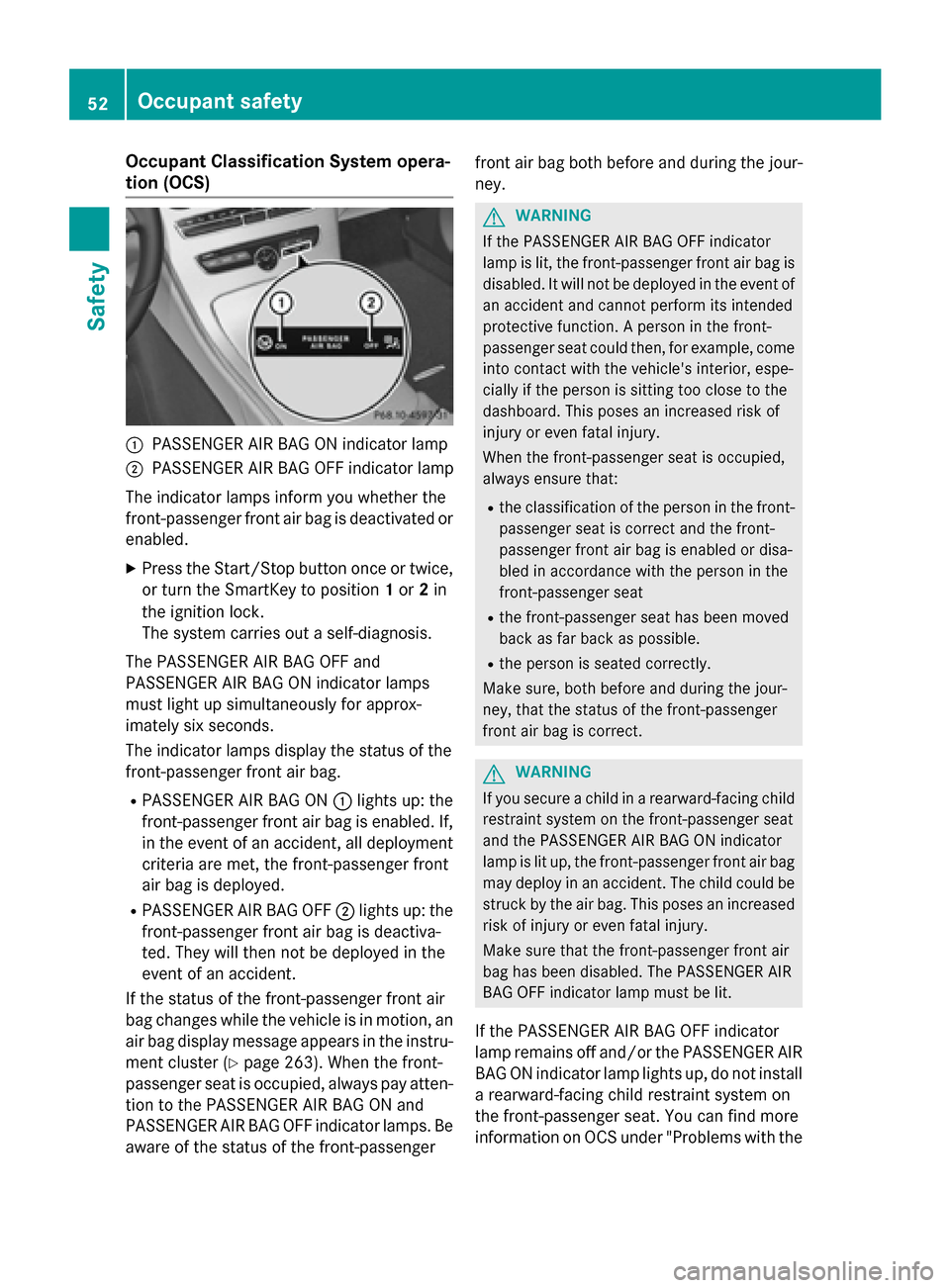
Occupant Classification System opera-
tion (OCS) 0043
PASSENGER AIR BAG ON indicator lamp
0044 PASSENGER AIR BAG OFF indicator lamp
The indicator lamps inform you whether the
front-passenger front air bag is deactivated or enabled.
X Press the Start/Stop button once or twice,
or turn the SmartKey to position 1or 2in
the ignition lock.
The system carries out a self-diagnosis.
The PASSENGER AIR BAG OFF and
PASSENGER AIR BAG ON indicator lamps
must light up simultaneously for approx-
imately six seconds.
The indicator lamps display the status of the
front-passenger front air bag.
R PASSENGER AIR BAG ON 0043lights up: the
front-passenger front air bag is enabled. If,
in the event of an accident, all deployment
criteria are met, the front-passenger front
air bag is deployed.
R PASSENGER AIR BAG OFF 0044lights up: the
front-passenger front air bag is deactiva-
ted. They will then not be deployed in the
event of an accident.
If the status of the front-passenger front air
bag changes while the vehicle is in motion, an
air bag display message appears in the instru-
ment cluster (Y page 263). When the front-
passenger seat is occupied, always pay atten-
tion to the PASSENGER AIR BAG ON and
PASSENGER AIR BAG OFF indicator lamps. Be aware of the status of the front-passenger front air bag both before and during the jour-
ney. G
WARNING
If the PASSENGER AIR BAG OFF indicator
lamp is lit, the front-passenger front air bag is disabled. It will not be deployed in the event of
an accident and cannot perform its intended
protective function. A person in the front-
passenger seat could then, for example, come
into contact with the vehicle's interior, espe-
cially if the person is sitting too close to the
dashboard. This poses an increased risk of
injury or even fatal injury.
When the front-passenger seat is occupied,
always ensure that:
R the classification of the person in the front-
passenger seat is correct and the front-
passenger front air bag is enabled or disa-
bled in accordance with the person in the
front-passenger seat
R the front-passenger seat has been moved
back as far back as possible.
R the person is seated correctly.
Make sure, both before and during the jour-
ney, that the status of the front-passenger
front air bag is correct. G
WARNING
If you secure a child in a rearward-facing child
restraint system on the front-passenger seat
and the PASSENGER AIR BAG ON indicator
lamp is lit up, the front-passenger front air bag may deploy in an accident. The child could be
struck by the air bag. This poses an increased risk of injury or even fatal injury.
Make sure that the front-passenger front air
bag has been disabled. The PASSENGER AIR
BAG OFF indicator lamp must be lit.
If the PASSENGER AIR BAG OFF indicator
lamp remains off and/or the PASSENGER AIR BAG ON indicator lamp lights up, do not install
a rearward-facing child restraint system on
the front-passenger seat. You can find more
information on OCS under "Problems with the 52
Occupant safetySafety